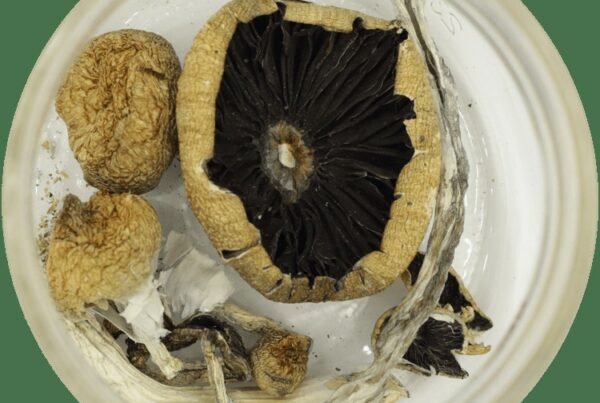Psilocybin mushrooms, much like LSD, behave as a serotonin 5-HT2A receptor agonist and are considered a traditional psychedelic. Current research is exploring their potential use in psilocybin-assisted therapy for mental health issues, including emotional distress from major depression, anxiety, cluster headaches, and migraines.
Understanding how shrooms help alleviate these conditions requires a deep dive into how they are metabolized in the body. This knowledge equips researchers and users with the ability to discern how the active compound triggers psychological and therapeutic effects. This article offers a basic overview of the pharmacology and pharmacokinetics of psilocybin.
[toc]
Key Takeaways:
- When psychedelic fungi are ingested, half of it is absorbed and distributed throughout the body.
- The fungi compound is dephosphorylated by the enzyme alkaline phosphatase, primarily in the liver.
- Within 24 hours, approximately 3.4% of the compound is expelled in its original form, with the majority being excreted as a stable metabolite.
What is Pharmacokinetics?
Pharmacokinetics (PK) is the discipline that studies how substances, like drugs, are processed by the body once ingested. While it’s related to pharmacodynamics, which explores how a compound interacts with the body, PK specifically focuses on four main aspects: absorption, distribution, metabolism, and excretion (ADME).
Understanding these processes enables medical professionals to prescribe the most effective medications with the least amount of risk. It also allows them to customize treatments based on each patient’s unique physiology and lifestyle.
How Does Pharmacokinetics Relate to Psilocybin?
Psilocybin and psilocin, the key active compounds in certain types of magic mushrooms, have attracted significant attention from both researchers and users. Pharmacokinetics looks at how the body processes mushrooms that contain psilocybin and aids in understanding their potential medicinal or recreational effects.
These compounds go by various names, including “magic,” “psychedelic,” “medicinal,” or “sacred.” The fungi containing these compounds are consumed, and the Mushroom species, their place of origin, size, growing and drying conditions, and age can all contribute to significant variations in their concentrations.
Although these mushrooms are naturally found in the wild, scientists have found ways to produce them synthetically in a lab. Both naturally occurring and synthesized mushrooms have low toxicity, though minor side effects such as nausea or vomiting might be experienced.
Despite these physical side effects, the compounds in these mushrooms have demonstrated potential therapeutic benefits due to their safety profile and non-addictive properties. These potential benefits have led to researchers investigating their use in psychotherapy, specifically for the treatment of anxiety and depression.
The 4 Phases of Pharmacokinetics
Psilocybin, the compound present in these mushrooms, is inactive in its initial form, acting as a prodrug that transforms into its active form, psilocin. Enzymes such as alkaline phosphatase assist in this transformation, enabling psilocin to be absorbed and distributed throughout the body, reaching various tissues. However, after oral ingestion, psilocybin cannot be detected in the circulatory system, feces, or urine.
Absorption
Absorption refers to the process by which the compound enters the bloodstream from its point of administration. It determines the rate and effectiveness with which the compound reaches its target, such as the plasma. Oral administration is the most common method used. Inhalation has been attempted but has not proven as effective as oral intake.
The absorption process also includes the release of the compound from the dosage form during oral consumption. Factors such as delays in the throat or esophagus can affect this, potentially slowing down the effects or causing discomfort. Once the compound reaches the stomach, the acidic environment may start breaking it down before it enters the bloodstream.
Studies on animals indicate that only about 50% of orally administered psychedelics are absorbed and distributed throughout the body.
Factors Affecting the Absorption Process
Several elements can affect the absorption process, resulting in variations in the onset, intensity, and duration:
- Stomach Contents: The presence of food in the stomach can delay the process as it slows down the onset of effects. An empty stomach facilitates quicker absorption.





